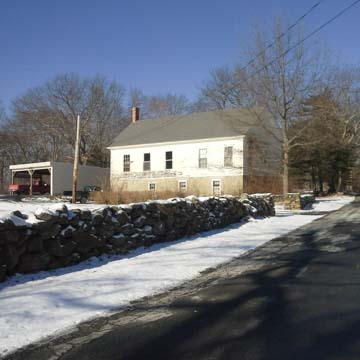Grange Road is an eighteenth-century road, its antiquity evident in its winding course and in the stone walls along it, but more remarkably in the preservation of a string of four small eighteenth-century farmhouses and an accompanying accumulation of fields, family cemeteries, mostly nineteenth-century outbuildings, and a late-nineteenth-century grange. All the houses are one and one-half stories and of clapboard; all but one have transom lights over their doors. The progression begins with the oldest of the group (just north of the intersection of Grange Road and Rocky Hill Road), the gambrel-roofed John Durran's Farm ( NS31; 152 Grange Road) with its door at one end of the front elevation, asymmetrically placed windows, and later dormers. A large barn, smaller storage building, former sawmill (all nineteenth century), and the family cemetery complete the farm. Opposite the intersection is Primrose Grange ( NS32; 1887), with another small family cemetery on the property. Nondescriptly plain, it became more awkward looking when it was raised in the early twentieth century to make another story. (Why are all Rhode Island granges almost without architectural appeal, when starkness in country schoolhouses and churches has left its share of memorable images?)
Next of interest, on the east side is a farmhouse (350 Grange Road) set well back. Nearby to its north is the former Andrews Schoolhouse, moved from across the road near the Rocky Hill corner and now used as an outbuilding. On a rise at a sharp bend and set very close to the road, is the Grayson Phillips Farm, number 391 (
NS33; c. 1790) with another family cemetery, and its barn hard by the road opposite. Unusually for the original date, the eaves are lifted away from the windows to provide a quarter story, with a pair of transomlike windows under the eaves. It could have resulted from a roof raising done at a later date when the motif would have been common. The front
Last is number 445, the N. Baker house ( NS34; c. 1780), where prim symmetry prevails at last, with a central chimney and eaves drawn snugly to the window tops. A small shingled barn (c. 1890) with an attached shingled shed (c. 1780, moved from another site nearby), and a three-hole privy seem to stake out the flat rectangular platform on which this farm sits. Two of its boundaries are further delimited by a picket fence. Again the road rises suddenly, turns and dips at the house. The beautiful modesty of these buildings, as well as their sensitive and varied relationship to fields and road, rebuke the strident heedlessness of the present. May this cluster of farmhouses, their fields, and the road itself survive to remind us of what much of rural Rhode Island once was.

